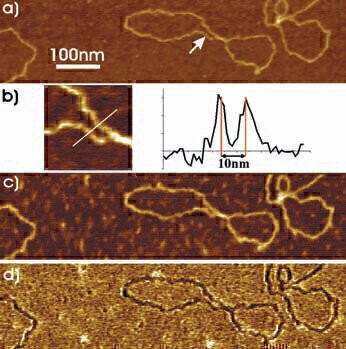Microscopy & Microtechniques
AFM used to Better Characterise Graphenes Properties
Jan 24 2012
JPK Instruments reports on a keynote paper in Nano Letters where Dr Nikolai Severin and his co-workers from the group of Professor Jürgen P. Rabe have applied JPK's NanoWizard®II Ultra system to improve their understanding of the properties of graphene. Within this group is Dr Nikolai Severin, recently the lead author of a paper in Nano Letters, which shows the use of AFM in the study of graphenes. The electronic properties of graphenes depend sensitively on
their deformation, and therefore strain-engineered graphene electronics is envisioned. In order to deform graphenes locally, the group has mechanically exfoliated single and few layer graphenes onto atomically flat mica surfaces covered with isolated double stranded plasmid DNA rings. Using scanning force microscopy in both contact and intermittent contact modes, they have found that the graphenes replicate the topography of the underlying DNA with high precision. The availability of macromolecules of different topologies, e.g., programmable DNA patterns render this approach promising for new graphene based device designs. Furthermore, the encapsulation of single macromolecules offers new prospects for analytical scanning probe microscopy techniques.
Dr Severin has seen that graphene provides enhanced protection of DNA molecules to shear forces exerted during scanning force microscopy in contact mode. In addition, graphene will act as a surface protective layer against the ambient, for example, against oxidation, since it is impermeable to gases. Taking into account both the high electric conductivity of graphene and its extremely small thickness, this offers new opportunities for scanning probe
microscopies and spectroscopies, such as scanning tunneling or tip enhanced Raman spectroscopy for analyses of both locally deformed graphene and confined molecules. Summarising, Dr Severin said: "We have successfully demonstrated that topography of graphenes can be controlled with the precision down to single molecules." He also commented on some of the reasons for choosing to work with JPK NanoWizard® II for this work: "We are able to use a relatively large size of samples and scan areas of up to 30 microns. The linearised scanner is most important for us to precisely measure the height of DNA and their cross sections. The system shows little thermal drift, which is important when making measurements on such small length scales. I also found the software was quite easy to use."
Digital Edition
Lab Asia 31.2 April 2024
April 2024
In This Edition Chromatography Articles - Approaches to troubleshooting an SPE method for the analysis of oligonucleotides (pt i) - High-precision liquid flow processes demand full fluidic c...
View all digital editions
Events
May 05 2024 Seville, Spain
InformEx Zone at CPhl North America
May 07 2024 Pennsylvania, PA, USA
May 14 2024 Oklahoma City, OK, USA
May 15 2024 Birmingham, UK
May 21 2024 Lagos, Nigeria





.jpg)












